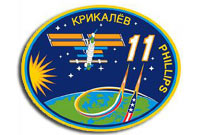NASA Space Station On-Orbit Status 17 July 2005

SpaceRef note: This NASA Headquarters internal status report, as presented here, contains additional, original material produced by SpaceRef.com (copyright © 2005) to enhance access to related status reports and NASA activities.
All ISS systems continue to function nominally, except those noted previously or below. Sunday – not quite an off-duty day for Sergei Krikalev & John Phillips because of the Soyuz relocation in two days. Ahead: Week 13 for Increment 11.
As part of today’s morning inspection after wakeup, the CDR did the periodic checkup behind panel 139 in the Service Module (SM) on a fluid connector of the urine collection system, looking for potential moisture.
|
Shuttle |
First thing after morning inspection, breakfast and daily planning meeting for the crew was a three-hour onboard training drill for the Soyuz TMA-6/10S relocation from the DC1 docking compartment to the FGB nadir port, scheduled for Tuesday, 7/19. [Today’s training, which was supported by ground specialist tagup via VHF & S-band, included Soyuz procedures analysis, relocation data analysis, tag-ups with instructor, and OBT (onboard training) simulator work. During the relocation, the ISS will be in “unmanned mode”. After Krikalev and Phillips have entered the Soyuz, they will close hatches, don their suits, and activate the spacecraft. The undock command from TsUP/Moscow is scheduled for 6:35am EDT. Soyuz 10 will back off, translate to the FGB and rotate around its long axis to index with the nadir port docking target. Final approach will begin at 7:08am, with docking concluding the maneuver at 7:15am. The maneuver times have been chosen to be within coverage of RGS (Russian ground sites). This time constraint requires a wake/sleep cycle shift for the crew. Tomorrow (Monday) their work day will therefore be shortened, with early sleep at 11:30am EDT. Tuesday will be a lengthened work day, with wakeup at 7:50pm tomorrow night and sleep time at 3:25pm on 7/19.]
FE/SO Phillips was scheduled to “ghost” another HDD (hard disk drive) for the PCS (Portable Computer System), loading HDD #6058 with current software from a CD-ROM. [An earlier attempt at loading HDD #6133 (on 7/4) did not succeed. A second good spare HDD will be needed for LF-1.]
|
|
John also conducted the periodic inspection of station bacterial filters and smoke detectors in the Airlock (A/L), Lab and Node. [There is one bacterial filter and smoke detector (SD) in the A/L, plus two SDs and one filter each in the Node and Lab.]
Krikalev worked on the BIO-5 Rasteniya-2 (“Plants-2”) experiment, completing the regular periodic download of data & imagery collected of the experiment to the computer for subsequent downlink to the ground. [Rasteniya researches growth and development of plants (currently horse radish) under spaceflight conditions in the Lada-7 greenhouse. The regular maintenance of the experiment (each Monday, Wednesday, Friday and Sunday) involves monitoring of seedling growth, humidity measurements, moistening of the substrate if necessary, topping off the water tank if ~20-25% of the total amount (4 liters) remains, and photo/video recording. On Thursdays data from the Lada greenhouse control unit are recorded on floppy disk for weekly downlink via REGUL-Packet or the new BSR-TM at a suitable occasion.]
Sergei also did the daily routine maintenance of the SM’s environment control & life support system (SOZh), including its toilet system (ASU), and he prepared the IMS (inventory management system) “delta” file for automated export/import top the three IMS databases.
Both crewmembers conducted their regular 2.5-hr. physical exercise program on the TVIS treadmill, RED resistive machine and VELO bike with bungee cord load trainer. [Sergei’s daily protocol prescribes a strict four-day microcycle exercise with 1.5 hr on the treadmill and one hour on VELO plus load trainer (today: Day 3 of a new set).]
Afterwards, John transferred the exercise data files to the MEC (Medical Equipment Computer) for downlink, as well as the daily wristband HRM (heart rate monitor) data of the workouts on RED, followed by their erasure on the HRM storage medium (done six times a week).
CEO photography can be viewed and studied at the websites:
- http://eol.jsc.nasa.gov
- http://earthobservatory.nasa.gov
- http://earthobservatory.nasa.gov/Study/AstronautPhotography/
See also the website “Space Station Challenge” at:
To view the latest photos taken by the expedition 11 crew visit:
- http://spaceflight.nasa.gov/gallery/images/station/crew-11/ndxpage1.html at NASA’s Human Spaceflight website.
Expedition 11 Flight Crew Plans can be found at http://spaceflight.nasa.gov/station/timelines/
Previous NASA ISS On-orbit Status Reports can be found here. Previous NASA Space Station Status Reports can be found here. Previous NASA Space Shuttle Processing Status Reports can be found here. A collection of all of these reports and other materials relating to Return to Flight for the Space Shuttle fleet can be found here.
ISS Altitude History
Apogee height — Mean Altitude — Perigee height

For more on ISS orbit and worldwide ISS naked-eye visibility dates/times, see http://www.hq.nasa.gov/osf/station/viewing/issvis.html. In addition, information on International Space Station sighting opportunities can be found at http://spaceflight.nasa.gov/realdata/sightings/ on NASA’s Human Spaceflight website. The current location of the International Space Station can be found at http://science.nasa.gov/temp/StationLoc.html at NASA’s Marshall Space Flight Center. Additional satellite tracking resources can be found at http://www.spaceref.com/iss/tracking.html.









